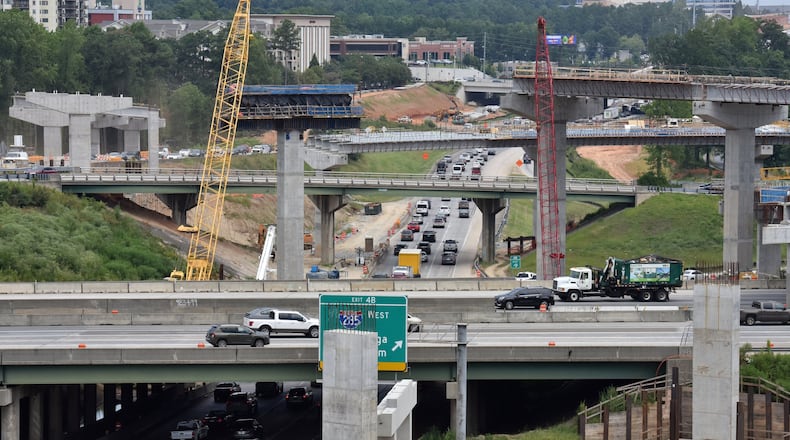Highway lanes and entrance ramps are closed. Local roads are blocked. Detours route traffic away from the direction motorists want to travel.
Welcome to one of the most congested stretches of highway in the country, which now doubles as one of the biggest road construction projects in Georgia history.
The Georgia Department of Transportation is rebuilding the junction of I-285 and Ga. 400 in Sandy Springs — ramp by ramp, lane by lane. When it's finished, state officials say it will make life better for hundreds of thousands of commuters. And it will serve as the linchpin of the region's growing network of toll lanes.
But don't expect traffic relief any time soon — construction will continue through the end of next year. And traffic may get worse in coming months as the work reaches its peak.
That’s bad news for commuters such as Laurie Stone of Milton, who works in Atlanta.
“It’s kind of like exercise,” she said of the construction. “There’s a reason why you’re doing it, and the end product will be desirable. But right now, it’s brutal.”
GDOT is spending $800 million to rebuild the interchange. The current structure was designed to accommodate 100,000 vehicles a day, but now about 420,000 vehicles pass through each day.
That’s a recipe for traffic headaches. An environmental assessment of the interchange found “rush hour” at I-285 and Ga. 400 often lasts three to four hours each in the morning and afternoon. Even in the middle of the day, congestion is common on both highways.
The new design will add a network of collector-distributor lanes and flyover ramps that will carry more vehicles and eliminate some traffic weaving. The construction extends 4.3 miles along the Perimeter and 6.2 miles along Ga. 400.
GDOT broke ground on the project nearly three years ago. Major construction began in 2017.
But recently the pillars and beams that will support the new interchange have begun rising from the red Georgia clay. For the first time, motorists can glimpse the colossal scale of the structure — it will be almost as big as Spaghetti Junction, where I-285 meets I-85 northeast of Atlanta.
“We’re approaching the peak of construction,” said Marlo Clowers, the GDOT manager overseeing the project. “I don’t think we’re quite there. But we’re very, very close.”
When it’s done, GDOT says the interchange will save commuters precious time. For example, rush-hour travel time on Ga. 400 from Northridge Road through the interchange may decrease up to 10 minutes.
But for now the area is a maze of construction barrels, detours and lane closures. Much of the work is done at night and on weekends. But daytime traffic sometimes crawls through the area. Just ask Stone.
The Milton resident saw her 24-mile commute grow to an hour and a half one way in recent years. Now it’s even worse, so she works from home as much as she can. When she can’t, she rises at 5:30 a.m. to beat the traffic.
“Right now, it’s awful,” Stone said. “I want to get out of their way and let them do their work.”
Kevin Lewis of Sandy Springs commutes to Midtown. On his return home, he usually gets off Ga. 400 at Glenridge Drive and takes back roads the rest of the way. Now traffic on Ga. 400 is so bad he exits at Lenox Road – nearly five miles sooner.
“It’s added 10 to 15 minutes to my evening commute, and I don’t even have to drive through (the construction),” Lewis said.
GDOT tries to give motorists the information they need to avoid the worst congestion. In recent days it has issued a flurry of alerts about nighttime lane closures on various parts of the Perimeter and Ga. 400. It also has warned of the overnight closure of a section of Peachtree Dunwoody Road and detours at various highway ramps.
“A project of this magnitude, it’s a massive amount of work, and a big push to keep people informed,” GDOT’s Clowers said.
But traffic alerts can only help so much. Until construction ends in late 2020, motorists can expect delays.
In the meantime, GDOT wants commuters to remember the payoff that will come when construction ends.
“When we live through the pain of construction,” Clowers said, “we’re going to have a very efficient facility that helps with mobility in this region and the state of Georgia.”
About the Author
The Latest
Featured



